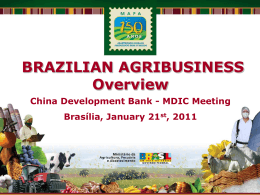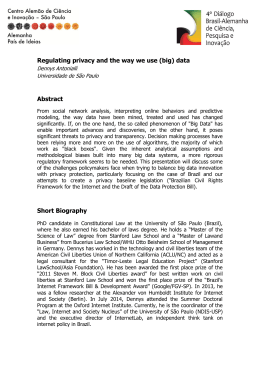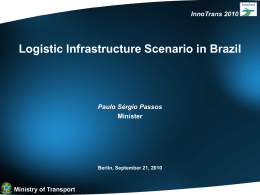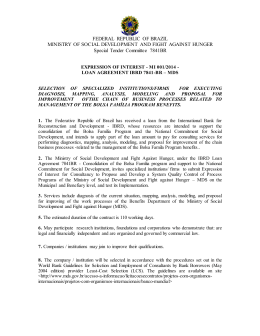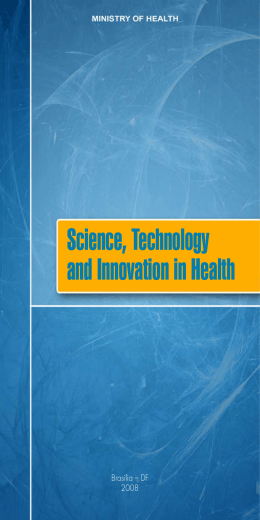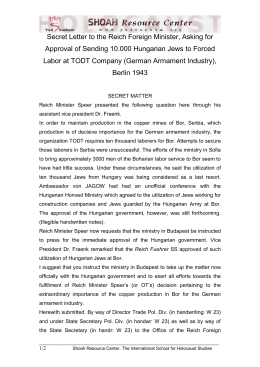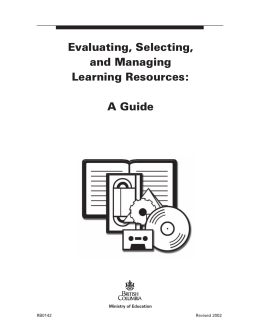Logistic Infrastructure Scenario in Brazil Marcelo Perrupato Secretary for Transportation National Policy Minneapolis, September 20, 2011 Ministry of Transportation Brazilian Economic Scenario Ministry of Transportation Positive GDP Growth for Brazil and China Annualized Quarter data * Forecasts: USA and China - JP Morgan and Brazil - Ministry of Finance Sources: BEA (USA), JPMorgan (China) and IBGE (Brasil) Ministry of Transportation Produced by: Ministry of Finance GDP Growth – International Comparison 2nd Quarter/09* - % * Growth relating to the previuos quarter (1st Q 2009) , updated annually and seasonally Source: GDW JP Morgan 09/11/2009 and IBGE for Brazil Ministry of Transportation GDP and Consumption Change in the last 12 months - % Source: IBGE Ministry of Transportation Produced by: Ministry of Finance Reduction of External Vulnerability US$ billion Source: Ministry of Development, Industry and Commerce. Ministry of Transportation Produced by: Ministry of Finance Total External Net Debt % of GDP * Forecast – July 2009 Source: Central Bank of Brazil Ministry of Transportation Produced by: Ministry of Finance Foreign Exchange Reserves (International Liquidity) *Position on September 8th, 2009. Source: Central Bank of Brazil. Ministry of Transportation Prepared by: Ministry of Finance US$ billion Logistic Infrastructure Ministry of Transportation Road Network In km JURISDICTION FEDERAL STATE MUNICIPAL TOTAL NATIONAL Ministry of Transportation PAVED NON PAVED TOTAL 60,469 13,604 74,073 122,889 119,429 242,318 24,104 1,256,188 1,280,292 207,462 1,389,221 1,596,683 Rail Network National Rail Network Federal Rail Network under Concession 28,314 km 12 concessions operated by 5 private groups and 2 state-owned companies Ministry of Transportation 29,817 km National Ports 50 public ports in Brazil – sea and river 26 Federal Port Companies and National Department for Transport Infrastructure (DNIT) 23 States and Municipalities 1 private sector Ministry of Transportation Inland Waterways 28,000 km of inland waterways Potential utilization of over 15,000 km of new waterways Transport of over 25 million tons/year Agricultural and mineral products, alcohol, construction material (sand, gravel), fertilizers Main Inland Waterways under operation Paraná – Tietê Amazonas - Madeira Tapajós Capim Tocantins – Araguaia São Francisco Paraguai Jacuí - Taquari and Lagoa dos Patos TOTAL 1,660 km 4,164 km 1,046 km 372 km 3,040 km * 1,371 km 1,323 km 670 km 13.646 km * Usable conditions Ministry of Transportation Inland Waterways system APROXIMATED EXTENSIONS (km) BASIN STATES MAIN RIVERS NAVIGABLE AMAZÔNICA AM, PA, AC, RO, RR, e AP NORDESTE POTENTIAL TOTAL* Amazonas, Solimões, Negro, Branco, Madeira, Purus, Juruá, Tapajós, Teles Pires, Juruena, Mamoré, e Guaporé 18,300 723.5 19,023 MA e PI 1,740 2,975 4,715 Mearim, Pindaré, Itapecuru, Parnaíba e Balsas TOCANTINS/ARAGUAIA TO, MA e GO 2,200 1,300 3,500 Tocantins, Araguaiae Mortes SÃO FRANCISCO MG, BA, PE e SE 1,400 2,700 4,100 São Francisco, Grande e Corrente LESTE MG, ES e RJ - 1,094 1,094 Doce, Paraíba do Sul e Jequitinhonha TIETÊ/PARANÁ SP, PR e SC 1,900 2,900 4,800 Paraná, Tietê, Paranaíba, Grande, Ivaí e Ivinheima PARAGUAI MT, MS e PR 1,280 1,815 3,095 Paraguai, Cuiabá, Miranda, São Lourenço, Taquari e Iaurú SUL RS 600 700 1,300 Jacuí, Taquarí,Lagoa dos Patos e Lagoa Mirim URUGUAI RS e SC - 1,200 1,200 Uruguai e Ibicuí 27,420 15,407.5 42,827.5 TOTAL * Not necessarily continuous stretches. Ministry of Transportation Ro-Ro Terminal in Manaus (State of Amazonas) Construction of Tucuruí Locks Ministry (State of Pará)of Transportation Convoy on a Tietê River Canal (State of São Paulo) Convoy on the Madeira River (States of Amazonas & Rondônia) Transport Policy and Planning Ministry of Transportation The transport matrix is unbalanced considering the size of Brazil 4% Road Rail Water Pipe/Air 13% 25% Ministry of Transportation 58% which is proved as compared with similar-size countries. Russia 81% 8% 11% Canada 46% 43% 11% Australia 43% 53% 4% USA 43% China Brazil 32% 37% 50% 25% Rail Ministry of Transportation 58% Road 25% 13% 17% Water & others To organize such scenario and recover the transport sector, the Ministry of Transport has developed the National Plan for Logistics and Transportation (PNLT) An instrument for strategic organization with an integrated view on the territory and development. Transport as an agent to induce and facilitate development. A more balanced Brazilian transport matrix with a significant participation of rail and water modes, which are more efficient in terms of economy and energy consumption, with less emission of CO2 and NOx. Ministry of Transportation PNLT indicates ways to change the transport matrix Consolidation of a new Brazilian rail network (Law 11772/2008) with the implementation of 11,800 km of new rail lines, with 10,700 km of large-gauge tracks. New railways will serve areas of agricultural & mineral new frontiers. This new basic railway system prepares the Country for a new economic growth cycle to meet the domestic demand increase and integration with exporting ports. Gradual transfer of general cargo from roads to railways, inland waterways, and coastal shipping. Ministry of Transportation The Brazilian power generation matrix is clean, based on hydro-electric plants. It is needed to make this feature compatible with navigation needs Power Generation Matrix – Brazil and the World (%) 100% 5 1 4 2 90% Other 80% 38 41 70% Coal 60% Hydraulic 50% 85 12 16 Nuclear 40% 23 30% 20% 10% 0% 15 20 20 3 3 3 4 6 BRAZIL 2007 OECD2006 483 TWh - 89% Ministry of Transportation 10,460 TWh - 16% Gas Petroleum WORLD 18,930 TWh - 18% % renewable Source: MME Power Generation Matrix in Brazil is markedly renewable Ministry of Transportation Energy consumption all sources (%) Souce: MME / BEM 2006 Ministry of Transportation Oil consumption by sectors (%) Source: MME / BEN 2006 Ministry of Transportation Transport Matrix - Present and Future 60 58 50 40 35 30 30 20 25 Road Rail 29 Water Pipe 13 10 Air 3.6 5 1 0.4 0 2005 2015 2020 Source: PNLT Processing, considering energy consumption Ministry of Transportation 2025 Benefits from the Transport Matrix change 2005 to 2023/2025 (Transport production grows from 851 to 1,510 bi TKU) 38% of energy efficiency increase 41% of fuel consumption reduction 32% of CO2 emission reduction 39% of NOx emission reduction Ministry of Transportation PAC Growth Acceleration Program Ministry of Transportation Background Brazil has faced a long period of low investment in logistic infrastructure Better economic conditions have allowed: Rehabilitation of public investment capability Favorable scenario for partnerships with the private sector • Road Concessions • Railroad Concessions Ministry of Transportation PAC After two decades, it is the first initiative to accomplish a significant program of investments in transportation Public investments selected from the PNLT Projects with strong potential for generating economic & social return Synergy among projects Rehabilitation of the existing infrastructure New projects and conclusion of projects under way Ministry of Transportation Main PAC’s Projects Highways Construction of new highways Expansion of the existing road capacity Rehabilitation of the existing road network 2,989 km 1,926 km 53,585 km Railways Rail network capacity increase Expansion of the rail network (12,000 km): 2,700 under construction; 1,500 to be built; 5,300 under studies & design; 2,500 under analysis Inland Waterways Construction of inland waterway terminals in Amazonia Construction of locks Incentive to Shipbuilding (Financing) Construction of ocean-going, coastal, maritime aid and river vessels (384 vessels, 103 of which finished) Construction and modernization of 8 shipyards Ministry of Transportation Partnerships with the Private Sector Ministry of Transportation Road Concessions 1st phase of the Federal Highway Concession Program 1,482 km in 3 States: Rio de Janeiro, São Paulo and Rio Grande do Sul (Concluded) 2nd phase of the Federal Highway Concession Program 3,228 km in 6 States: Bahia, Minas Gerais, Rio de Janeiro, São Paulo, Paraná and Santa Catarina (Concluded) 3rd phase of Federal Highway Concession Program 2,230 km in 5 States: Minas Gerais, Espírito Santo, Goiás, Federal District and Santa Catarina Bidding in 2010 Ministry of Transportation FEDERAL HIGHWAY CONCESSION PROGRAM Niterói 1st Phase 1,482 km 2nd Phase 3,228 km 3rd Phase 2,230 km Ministry of Transportation Railway Program Public investment together with private funds from the entrepreneur North-South Railway • 719 km – Açailândia/MA – Palmas/TO – sub-concession concluded in Dec. 2007 • 1,535 km – Palmas/TO – Estrela d’Oeste/SP – under way: construction works, section Palmas/Anápolis (855 km); and studies relating the section Anápolis/Estrela d’Oeste (680 km) West-East Integration Railway • 1,490 km – Figueirópolis-TO / Ilhéus-BA • Studies and project under way Ministry of Transportation Projects for Railways Expansion in Brazil Ministry of Transportation High Speed Train Rio de Janeiro – São Paulo – Campinas Extension: 511 km Serves the most populous and economically developed region in Brazil Studies on demand, alignment, geology, operation and economic-financial modeling are concluded Call for bidding and auction for technology: 1st semester of 2012 Transfer of technology is mandatory The winner will be responsible for : final engineering design maintenance operation Call for bidding and auction for the High Speed Train: Construction Ministry of Transportation High Speed Train Rio de Janeiro - São Paulo - Campinas PROPOSED STATIONS STATION LOCATIONS Ministry of Transportation Major Directives from the Ministry of Cities for Urban Mobility Implement corridors and transport equipments for all major cities with more than 300 thousand inhabitants, state capitals and metropolitan regions, focusing bus and rail systems, including 60% expansion in the existing metro network PAC mobilility goals: Existing network: 215,7 km Expansion of 133,5 km up to 2022 Metro network (São Paulo, Rio, Recife, B. Horizonte, Salvador, Fortaleza, Brasília) Rail & VLT (São Paulo, Rio, P. Alegre, Natal, Salvador, J. Pessoa, Recife, Fortaleza, Maceió, N. Hamburgo, Curitiba) Ministry of Transportation • Metrô de Fortaleza • Trens de superfície – Fortaleza (METROFOR) • Linha Oeste (VLT) • Trens de superfície - Natal • Trens de superfície – João Pessoa • Metrô de Recife • Trens de superfície - Recife • Trens de superfície - Maceió • Metrô de Salvador • Trem de subúrbio de Salvador • Metrô de Brasília • Metrô de Belo Horizonte • Metrô do Rio de Janeiro • Rio de Janeiro - SUPERVIA • Metrô, monotrilho e VLT de São Paulo • Trens de superfície – São Paulo – CPTM • Trens de superfície - Porto Alegre Ministry of Transportation São Paulo Metro 4 existing lines totalling 62.3 km 3,500,000 pax/day 12 km expansion (private operation) 11 km of new line (5) in 2015 24 km of 2 monorail lines in 2014 Expansion Expresso Tiradentes - 23 km monorail Expansion of 6 km Orange line subway. Basic Design 12 km Monorail or VLT: S. Bernardo-São Paulo CPTM VLT Ministry of Transportation 6 existing lines totalling 260.8 km 2,150,000 pax/day New line (13) with 20 km in 2025 84 new trains (8 cars each) in 2014 Design Capacity: 4,100,000 pax/day(3 min headway) PPP operation under analysis mapa Maceió Diesel VLT Ministry of Transportation 1 existing line totalling 32.1 km 6,000 pax/day System is under improvement with VLT rolling stock mapa Salvador Surface Rail 1 existing line totalling 17 km 12,000 pax/day Under improvement Public operation Salvador Metro Ministry of Transportation 1 existing line totalling 6 km Expansion to 12 km in 2011 200,000 pax/day forecast Public operation mapa Fortaleza Metro South Line (under construction) 1 line totalling 17 km 190,000 pax/day Operation in 2011 2 lots of 10 trains each (with 4 cars) Fortaleza Diesel VLT West line Ministry of Transportation 1 existing line totalling 21 km 8,000 pax/day May be expanded for integration with the metro system State public operation mapa Brasília Metro Brasília Ministry of Transportation 1 existing line totalling 40.3 km 120,000 pax/day Expansion of Rolim stock for 190,000 pax/day Public Operation mapa Belo Horizonte Metro - CBTU Ministry of Transportation 1 existing line totalling 2.2 km 170,000 pax/day Capacity forecast: 240,000 pax/day Need for 10 new trains (4 cars each) Final engineering design for Lines 2 and 3 totalling 33.8 km mapa João Pessoa VLT - CBTU Ministry of Transportation 1 existing line totalling 30 KM 11,000 pax/day Design for improvement under analysis mapa Recife Metro - CBTU 2 existing lines totalling 39.7 km 220,000 pax/day 15 TUE (eletric train unit) Public operation Recife VLT South Line Ministry of Transportation 2 existing lines totalling 26.1 km 6,000 pax/day Under improvement (connecting to SUAPE Industrial Port) PAC I mapa Rio de Janeiro Metro 2 existing lines totalling 35.6 km 550,000 pax/day Line 4 under construction with14 km (Ipanema - Barra da Tijuca) Demand forecast 250,000 pax/day Prospective construction of Line 3 (Niterói -São Gonçalo) for Olympic Games 2016 Rio de Janeiro Metro SUPERVIA Ministry of Transportation 5 existing lines totalling 225 km 500,000 pax/day 1,100,000 pax/day demand forecast Lines and Stations Improvement with 90 addition TUE (eletric train units) to attend Olympic Games 2016 mapa Natal Diesel VLT Ministry of Transportation 2 existing lines totalling 56.2 km 7,000 pax/day Future improvement under analysis mapa Porto Alegre VLT TRENSURB Ministry of Transportation 1 existing line totalling 33.8 km 160,000 pax/day Expansion of 9 km in 2011 with 8 new TUE (6 cars each) Demand forecast: 200,000 pax/day mapa Passengers traffic on railway cargo network Low demand cargo lines: Feasibility studies are financed by the Ministry of Transport and implementation and operation by private enterprises, basically for tourism sector (14 prospective services throughout the Country) Regular demand cargo lines: Passengers traffic operated in non priority basis New railway expansion lines: Passengers traffic may be effectively operated in regular basis (under analysis by the Government) Ministry of Transportation Highlights of the Inland Waterway Sector Ministry of Transportation Inland Waterway Map Navigable stretches Ministry of Transportation Inland Waterway Development Brazil is already developing the rehabilitation and structuring of the railway system Now the challenge is to structure an inland waterway system that contributes to a better equilibrium of the Brazilian transport matrix in terms of energy, economy and sustainability Such an arrangement implies a governmental articulation concerning the multiple use of water resources and the appropriate environmental handling Ministry of Transportation Strategic Inland Waterway Plan Structures an organized and comprehensive instrument that, on the basis of the main potential-navigation hydrographic regions, aims to: Identify dredging and rock blasting works Identify and ranking works of dam crossing Structure inland waterway terminals Define institutional parameters for the inland waterway sector, considering the multiple use of water (water supply, irrigation, energy generation (Brazilian matrix is clean, basically hydro-electric generation), recreation, sanitation and transportation Strong articulation and integration with other public and private agencies (especially the National Water Agency) Ministry of Transportation Inland Waterway Regions LEGEND Amazônica Tocantins / Araguaia Atlântico Nordeste Ocidental Parnaíba Atlântico Nordeste Oriental São Francisco Atlântico Leste Atlântico Sudeste Atlântico Sul Paraguai Paraná Uruguai Source: Divisão Hidrográfica Nacional, Conselho Nacional de Recursos Hídricos, Resolução nº 32 de 15 de outubro de 2003. Ministry of Transportation Opportunities for Cooperation All those points, specially concerning the increasing of the railway network, represent challenges to be faced by Brazil, as well as opportunities for transferring technology and international experience and for partnership on investments. Worldwide countries will certainly be important partners in such a process. Ministry of Transportation www.transportes.gov.br F@le com o Ministério Ministry of Transportation
Download


